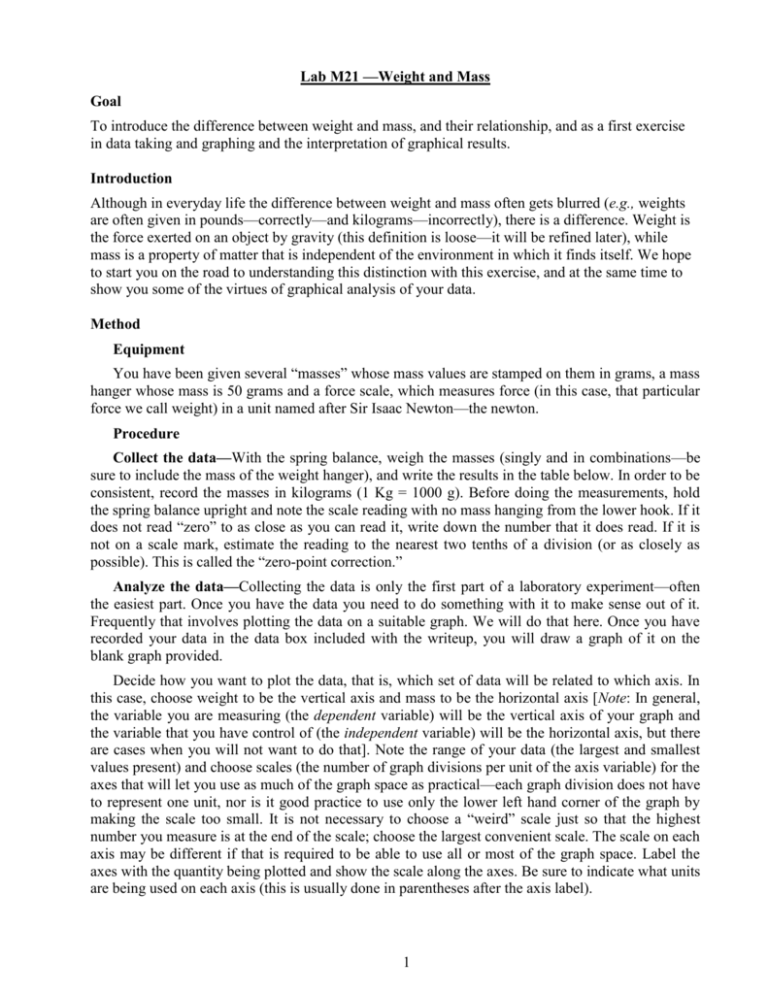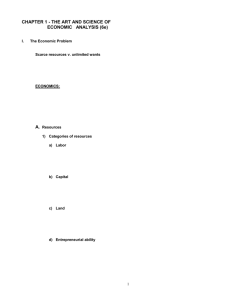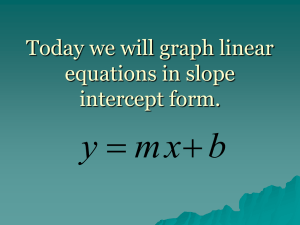Lab M21 —Weight and Mass - ncssm
advertisement

Lab M21 —Weight and Mass Goal To introduce the difference between weight and mass, and their relationship, and as a first exercise in data taking and graphing and the interpretation of graphical results. Introduction Although in everyday life the difference between weight and mass often gets blurred (e.g., weights are often given in pounds—correctly—and kilograms—incorrectly), there is a difference. Weight is the force exerted on an object by gravity (this definition is loose—it will be refined later), while mass is a property of matter that is independent of the environment in which it finds itself. We hope to start you on the road to understanding this distinction with this exercise, and at the same time to show you some of the virtues of graphical analysis of your data. Method Equipment You have been given several “masses” whose mass values are stamped on them in grams, a mass hanger whose mass is 50 grams and a force scale, which measures force (in this case, that particular force we call weight) in a unit named after Sir Isaac Newton—the newton. Procedure Collect the data—With the spring balance, weigh the masses (singly and in combinations—be sure to include the mass of the weight hanger), and write the results in the table below. In order to be consistent, record the masses in kilograms (1 Kg = 1000 g). Before doing the measurements, hold the spring balance upright and note the scale reading with no mass hanging from the lower hook. If it does not read “zero” to as close as you can read it, write down the number that it does read. If it is not on a scale mark, estimate the reading to the nearest two tenths of a division (or as closely as possible). This is called the “zero-point correction.” Analyze the data—Collecting the data is only the first part of a laboratory experiment—often the easiest part. Once you have the data you need to do something with it to make sense out of it. Frequently that involves plotting the data on a suitable graph. We will do that here. Once you have recorded your data in the data box included with the writeup, you will draw a graph of it on the blank graph provided. Decide how you want to plot the data, that is, which set of data will be related to which axis. In this case, choose weight to be the vertical axis and mass to be the horizontal axis [Note: In general, the variable you are measuring (the dependent variable) will be the vertical axis of your graph and the variable that you have control of (the independent variable) will be the horizontal axis, but there are cases when you will not want to do that]. Note the range of your data (the largest and smallest values present) and choose scales (the number of graph divisions per unit of the axis variable) for the axes that will let you use as much of the graph space as practical—each graph division does not have to represent one unit, nor is it good practice to use only the lower left hand corner of the graph by making the scale too small. It is not necessary to choose a “weird” scale just so that the highest number you measure is at the end of the scale; choose the largest convenient scale. The scale on each axis may be different if that is required to be able to use all or most of the graph space. Label the axes with the quantity being plotted and show the scale along the axes. Be sure to indicate what units are being used on each axis (this is usually done in parentheses after the axis label). 1 The data points you will have plotted here should fall in something approximating a straight line. Now estimate by eye the best straight line fit to the data and draw that line on the graph. The resulting line need not pass through all the data points, or (at least in this case) the origin—in fact, unless your data is perfect, or you draw your line with a dull crayon (not recommended), the line won’t pass through all the data points. This, in effect, averages your data. Drawing lines in this way—by eye—is a learned skill and one that you can get quite good at with a little practice. A final pointer on graphing techniques: mark each data point with some easily read symbol, such as a cross (+ or x) or a circle, square or triangle (only one symbol for each line to be drawn). A simple dot is too easily missed among the grid lines or mistaken for a flaw or extraneous mark on the paper. An example, using actual data taken during an execution of this experiment on “Planet X” is shown in Figure 1. 4.5 3.75 Weight, W (N) 3.0 W 2.25 1.5 m 0.75 0 0.1 0.2 0.3 0.4 0.5 0.6 Mass, m (Kg) Figure 1 A sample graph of weight vs. mass One way to see how good your line is is to sight across the paper at a nearly flat angle, looking along the line from the direction of the origin. If your line is good, the data points should “merge” together with about equal “weight” on either side of the line. If the points seem to form a line that is not coincident with the one you have drawn, either displaced or pointing in a slightly different direction, your line could probably be better. If one of your data points lies well away from the line suggested by the rest of the points you will need to decide whether that point should be kept or not, 2 or whether to remeasure that point. The general rule is, discard data points with reluctance; remeasure first, unless it is impractical or impossible to do so. If however, you decide to keep a questionable data point but don’t have much confidence in it because it lies well outside the region occupied by the other points, you might adjust your line slightly, giving this “outlier” less influence in choosing your line than you do the other data points. Among the advantages of graphing our data are, first that it helps us to visualize what is going on, and second it aids further analysis. Since our data suggests that the relationship between weight and mass is linear (i.e., a straight line), the obvious first step after completing the plot and drawing the line, is to measure the slope of the line. As shown in Figure 1, the slope should be measured using the line itself and not the data points. It is proper to use a large triangle in measuring the slope in order to maximize the precision of the measurement, as indicated in Figure 1. Before proceeding, we need to define a simple mathematical operation associated with taking the slope. The slope of the line is frequently described as “the rise divided by the run,” in other words, the difference along the vertical axis for a given amount along the horizontal axis. These amounts are always taken to be the final, or rightmost value, less the initial, or leftmost value in the chosen range. In Figure 1, the quantity mf – mi is indicated by the symbol ∆m, where the Greek letter “delta” (∆) means “difference between the final and initial values.” The value on the vertical axis is found by taking the W-value corresponding to the value of mf and subtracting from it the W-value corresponding to mi. Thus we can write the equation for the slope of the line as W –W slope = mf – m i = W m f i For the example of Figure 1 we have chosen mf = .54 Kg and mi = .14 Kg, so ∆m = 0.40 Kg. The values of W corresponding to mf and mi are Wf = 4.09 N and Wi = 1.05 N, so ∆W = 3.04 N. Using the formula above gives a slope of 7.6 N/Kg. Figure 2 gives the same representation of the slope but in a picture that may be a bit clearer without the background of the grid lines. It is important to remember that the value chosen for the “run” in calculating the slope should be as large as practical for the graph and that the triangle generated must close on the line drawn, irrespective of the location of specific data points. The slope refers to the line and not to the data. + Data points + + + y y slope =— x x "Best fit" line Figure 2 Measuring the slope 3 The North Carolina School of Science and Mathematics PH302 8/22/06 Name____________________________ Lab partner____________________________ Block___________ Lab Report M21—Weight and Mass Your report should include these pages, with the data box and graph filled in and the questions answered. Work in pairs but each person should get one complete set of data of their own. Let one person do the weighing and the other write the results for one set of data, then switch jobs for the other set of data. Once you have your sets of data you should do your analysis independently. Results Data Note the zero point correction, if any, and enter it here. Zero mass scale reading:________N Describe the effect of this number on the values of weight you read, and indicate how you must correct the readings for this “zero point error.” Read the scale on the spring balance as accurately as you can (to at least two tenths of a scale division). Record the corrected readings in the table below. Mass (Kg) Weight (N) Corr. Wt (N) Analysis Now plot the data on the graph on the next page (use the corrected weights, rather than the actual weights, from your data table above), with weight on the vertical axis and mass on the horizontal. Use the sample graph of Figure 1 as a guideline for constructing this graph. Remember to mark the data points with a symbol that will distinguish them from the background grid and from any random marks on the paper—in other words, don’t just put dots on the graph, use x, or , or or something else distinctive. Once you have put in all the data points, draw the best straight line through them. This line does not have to touch all the data points, or even any of them, but it should represent the best line that could be described by the points. Find the slope of the line you drew, using the method outlined in Figures 1 and 2. Show your calculation below. Always begin any calculation by writing the name of the thing you are going to calculate (in this case, “slope”), followed by an = sign, followed by the symbolic formula for what you will calculate. Then substitute in numbers with units. Finally, give your result with its units. Note this number. We will have occasion to use it (in a somewhat refined form) frequently in the future 2 Discussion 1. What is the significance of this number? (Questions like this do not call for long-winded answers; if you know the answer, a single brief sentence should be enough.) Some of you may know that this number is a physical constant known as “g.” Since we have not studied this yet, this is not what we are looking for. Instead, we are interested in how the number you have found defines a relationship between weight and mass. 2. If you hadn’t made the zero point correction, how would your graph have been changed? On the graph below, reproduce the line you originally drew and on the same graph draw the line as it would appear without the zero point correction. Label the two lines appropriately so that someone reading your report can easily interpret your graph. Is the slope of the new line different from what you obtained above? Explain. 3





